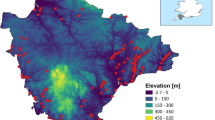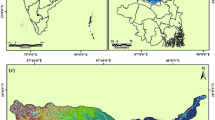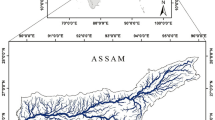Abstract
Flooding is a very common worldwide natural hazard causing large-scale casualties every year; Iran is not immune to this thread as well. Comprehensive flood susceptibility mapping is very important to reduce losses of lives and properties. Thus, the aim of this study is to map susceptibility to flooding by different bivariate statistical methods including Shannon’s entropy (SE), statistical index (SI), and weighting factor (Wf). In this regard, model performance evaluation is also carried out in Haraz Watershed, Mazandaran Province, Iran. In the first step, 211 flood locations were identified by the documentary sources and field inventories, of which 70% (151 positions) were used for flood susceptibility modeling and 30% (60 positions) for evaluation and verification of the model. In the second step, ten influential factors in flooding were chosen, namely slope angle, plan curvature, altitude, topographic wetness index (TWI), stream power index (SPI), distance from river, rainfall, geology, land use, and normalized difference vegetation index (NDVI). In the next step, flood susceptibility maps were prepared by these four methods in ArcGIS. As the last step, receiver operating characteristic (ROC) curve was drawn and the area under the curve (AUC) was calculated for quantitative assessment of each model. The results showed that the best model to estimate the susceptibility to flooding in Haraz Watershed was SI model with the prediction and success rates of 99.71 and 98.72%, respectively, followed by Wf and SE models with the AUC values of 98.1 and 96.57% for the success rate, and 97.6 and 92.42% for the prediction rate, respectively. In the SI and Wf models, the highest and lowest important parameters were the distance from river and geology. Flood susceptibility maps are informative for managers and decision makers in Haraz Watershed in order to contemplate measures to reduce human and financial losses.







Similar content being viewed by others
References
Akgun, A. (2012). A comparison of landslide susceptibility maps produced by logistic regression multi criteria decision and likelihood ratio methods a case study at İzmir Turkey. Landslides, 9(1), 93–106.
Althuwaynee, O. F., Pradhan, B., Park, H. J., & Lee, J. H. (2014). A novel ensemble bivariate statistical evidential belief function with knowledge based analytical hierarchy process and multivariate statistical logistic regression for landslide susceptibility mapping. Catena, 114, 21–36.
Asgharizadeh, E., & Nasrolahi, M. (2006). Comparison between fuzzy and Shannon entropy by PROMETHEE model for Iran-Khodro company (Saipa), The 4th International Management Conference. In Persian
Bahremand, A., De Smedt, F., Corluy, J., Liu, Y., Poorova, J., Velcicka, L., & Kunikova, E. (2007). WetSpa model application for assessing reforestation impacts on floods in Margecany-Hornad Watershed, Slovakia. Water Resources Management, 21(8), 1373–1391.
Bednarik, M., Magulová, B., Matys, M., & Marschalko, M. (2010). Landslide susceptibility assessment of the Kralˇovany–Liptovsky’ Mikuláš railway case study. Physics and Chemistry of the Earth, Parts A/B/C, 35(3), 162–171.
Botzen, W., Aerts, J., & van den Bergh, J. (2013). Individual preferences for reducing flood risk to near zero through elevation. Mitigation Adaptation Strategies Global Change, 18, 229–244.
Cevik, E., & Topal, T. (2003). GIS-based landslide susceptibility mapping for a problematic segment of the natural gas pipeline Hendek Turkey. Environmental Geology, 44(8), 949–962.
Chang-Jo, F., & Fabbri, A. G. (2003). Validation of spatial prediction models for landslide hazard mapping. Natural Hazards, 30(3), 451–472.
Chen, Y. R., Yeh, C. H., & Yu, B. (2011). Integrated application of the analytic hierarchy process and the geographic information system for flood risk assessment and flood plain management in Taiwan. Natural Hazards, 59(3), 1261–1276.
Chung, C. F., Fabbri, A. G., & van Western, C. (1995). Multivariate regression analysis for landslide susceptibility zonation. In A. Carrara & F. Guzzetti (Eds.), Geographical information system in assessing natural hazards (pp. 107–133). Dordrechat: Kluwer.
Cloke, H., & Pappenberger, F. (2009). Ensemble flood forecasting: a review. Journal of Hydrology, 375(3), 613–626.
Dai, F. C., & Lee, C. F. (2002). Landslide characteristics and slope instability modeling using GIS, Lantau Island, Hong Kong. Geomorphology, 42, 213–228.
De Moel, H., & Aerts, J. (2011). Effect of uncertainty in land use, damage models and inundation depth on flood damage estimates. Natural Hazards, 58, 407–425.
Elkhrachy, I. (2015). Flash flood hazard mapping using satellite image and GIS tools: a case study of Najran city, Kingdom of Saudi Arabia KSA. Egyptian Journal of Remote Sensing and Space Science, 18, 261–278.
Felicisimo, A., Cuartero, A., Remondo, J., & Quiros, E. (2012). Mapping landslide susceptibility with logistic regression, multiple adaptive regression splines, classification and regression trees, and maximum entropy methods: a comparative study. Landslides. doi:10.1007/s10346-012-0320-1.
Gashaw, W., & Legesse, D. )2011). Flood hazard and risk assessment using GIS and remote sensing in Fogera Woreda, Northwest Ethiopia, Nile River Basin. Springer Netherlands 179–206
Glade, T. (1998). Establishing the frequency and magnitude of landslide-triggering rainstorm events in New Zealand. Environmental Geology, 35, 160e–1174.
Glenn, E., Morino, K., Nagler, P., Murray, R., Pearlstein, S., & Hultine, K. (2012). Roles of saltcedar Tamarix spp. and capillary rise in salinizing a non-flooding terrace on a flow-regulated desert river. Journal of Arid Environment, 79, 56–65.
Gokceoglu, C., Sonmez, H., Nefeslioglu, H. A., Duman, T. Y., & Can, T. (2005). The 17 March 2005 Kuzulu landslide (Sivas, Turkey) and landslide-susceptibility map of its near vicinity. Engineering Geology, 81, 65–83.
Hosseinpoor Milaghardan, A., & Abbaspoor, R. A. (2015). Improving landslide prediction results using Shannon entropy theory. Journal Hazards Sciences, 1(2), 253–268 (In Persian).
Jaafari, A., Najafi, A., Pourghasemi, H. R., Rezaeian, J., & Sattarian, A. (2014). GIS-based frequency ratio and index of entropy models for landslide susceptibility assessment in the Caspian forest, northern Iran. International Journal Environmental Science and Technology, 11(4), 909–926.
Jayakrishnan, R., Srinivasan, R., Santhi, C., & Arnold, J. G. (2005). Advances in the application of the SWAT model for water resources management. Hydrological Processes, 19, 749–762.
Jebur, M. N., Pradhan, B., & Tehrany, M. S. (2013). Using ALOS PALSAR derived high resolution DInSAR to detect slow-moving landslides in tropical forest: Cameron Highlands, Malaysia. Geomatics, Natural Hazard and Risk, 1–19. doi:10.1080/19475705.2013.860407.
Jebur, M. N., Pradhan, B., & Tehrany, M. S. (2014). Optimization of landslide causative factors using very high-resolution airborne laser scanning (LiDAR) data at catchment scale. Remote Sensing of Environment, 152, 150–165.
Kazakis, N., Kougias, l., & Patsialis, T. (2015). Assessment of flood hazard areas at a regional scale using an index-based approach and analytical hierarchy process: application in Rhodope-Evros region, Greece. Science of the Total Environment. doi:10.1016/j.scitotenv.2015.08.055.
Khosravi, K., Nohani, E., Maroufinia, E., & Pourghasemi, H. R. (2016). A GIS-based flood susceptibility assessment and its mapping in Iran: a comparison between frequency ratio and weights-of-evidence bivariate statistical models with multi-criteria decision-making technique. Natural Hazards, 83(2), 1–41.
Kia, M. B., Pirasteh, S., Pradhan, B., Mahmud, A. R., Sulaiman, W. N. A., & Moradi, A. (2012). An artificial neural network model for flood simulation using GIS: Johor River basin, Malaysia. Environmental Earth Sciences, 67, 251–264.
Konadu, D., & Fosu, C. (2009). Digital elevation models and GIS for watershed modelling and flood prediction—a case study of Accra Ghana, In Appropriate Technologies for Environmental Protection in the Developing World. Springer, pp. 325–332.
Kourgialas, N. N., & Karatzas, G. P. (2011). Flood management and a GIS modelling method to assess flood-hazard areas—a case study. Hydrological Sciences Journal, 56(2), 212–225.
Lee, S., Ryu, J. H., & Kim, I. S. (2007). Landslide susceptibility analysis and its verification using likelihood ratio, logistic regression, and artificial neural network models case study of Youngin, Korea. Landslides, 4, 327–338.
Lee, M.J., Kang, J.E., & Jeon, S. (2012). Application of frequency ratio model and validation for predictive flooded area susceptibility mapping using GIS. In: Geoscience and Remote Sensing Symposium (IGARSS), Munich. 895–898
Li, X. H., Zhang, Q., Shao, M., & Li, Y.L. (2012). A comparison of parameter estimation for distributed hydrological modelling using automatic and manual methods. Advanced Materials Research, 356–360, 2372–2375.
Liu, Y.B., & De Smedt, F. (2004). WetSpa extension, a GIS-based hydrologic model for flood prediction and watershed management. Department of Hydrology and Hydraulic Engineering Vrije Universiteit Brussel. Vrije Universiteit Brussel: Brussels.
Liu, Y., & De Smedt, F. (2005). Flood modeling for complex terrain using GIS and remote sensed information. Water Resources Management, 19, 605–624.
Massey, D. S., & Nancy, A. D. (1988). The dimensions of residential. Social Forces, 67(2), 281–315.
Meng, Q., Miao, F., Zhen, J., Wang, X., Wang, A., Peng, Y., & Fan, Q. (2015). GIS based landslide susceptibility mapping with logistic regression, analytical hierarchy process, and combined fuzzy and support vector machine methods: a case study from Wolong Giant Panda Natural Reserve, China. Bulletin Engineering Geology and the Environment. doi:10.1007/s10064-015-0786-x.
Mohammady, M., Pourghasemi, H. R., & Pradhan, B. (2012). Landslide susceptibility mapping at Golestan Province, Iran: a comparison between frequency ratio, Dempster–Shafer, and weights-of-evidence models. Journal of Asian Earth Science, 61, 221–236.
Montgomery, D. R. (1994). Road surface drainage, channel initiation, and slope instability. Water Resources Research, 30, 1925–1932.
Naghibi, S. A., Pourghasemi, H. R., Pourtaghi, Z. S., & Rezaei, A. (2014). Groundwater qanat potential mapping using frequency ratio and Shannon’s entropy models in the Moghan Watershed, Iran. Earth Science Informatics. doi:10.1007/s12145-014-0145-7.
Nampak, H., Pradhan, B., & Manap, M. A. (2014). Application of GIS based data driven evidential belief function model to predict groundwater potential zonation. Journal of Hydrology, 513, 283–300.
Oh, H. J., & Lee, S. (2010). Cross-validation of logistic regression model for landslide susceptibility mapping at Geneoung areas, Korea. Disaster Advance, 3, 44–55.
Oh, H. J., & Pradhan, B. (2011). Application of a neuro-fuzzy model to landslide susceptibility mapping for shallow landslides in a tropical hilly area. Computer and Geosciences, 37, 1264–1276.
Oztekin, B., & Topal, T. (2005). GIS-based detachment susceptibility analyses of a cut slope in limestone, Ankara-Turkey. Environmental Geology, 49, 124–132.
Plate, E. J. (2009). HESS opinions: classification of hydrological models for flood management. Hydrology and Earth System Sciences, 13, 1939–1951.
Pourghasemi, H. R., & Kerle, N. (2016). Random forest-evidential belief function based landslide susceptibility assessment in western Mazandaran Province, Iran. Environmental Earth Sciences, 75, 185. doi:10.1007/s12665-015-4950-1.
Pourghasemi, H. R., Mohammadi, M., & Pradhan, B. (2012a). Landslide susceptibility mapping using index of entropy and conditional probability models at Safarood Basin, Iran. Catena, 97, 71–84.
Pourghasemi, H. R., Pradhan, B., & Gokceoglu, C. (2012b). Application of fuzzy logic and analytical hierarchy process (AHP) to landslide susceptibility mapping at Haraz watershed, Iran. Natural Hazards. doi:10.1007/s11069-012-0217-2.
Pourghasemi, H.R., Pradhan, B., & Gokceoglu, C. (2012c). Remote sensing data derived parameters and its use in landslide susceptibility assessment using Shannon’s entropy and GIS. Applied Mechanics and Materials, 225, 486–491.
Pourghasemi, H. R., Moradi, H., & Fatemi Aghda, S. M. (2013). Landslide susceptibility mapping by binary logistic regression, analytical hierarchy process, and statistical index models and assessment of their performances. Natural Hazards, 69, 749–779.
Pradhan, B. (2009). Groundwater potential zonation for basaltic watersheds using satellite remote sensing data and GIS techniques. Central European Journal of geoscience, 1(1), 120–129.
Pradhan, B. (2010a). Flood susceptible mapping and risk area delineation using logistic regression, GIS and remote sensing. Journal of Spatial Hydrology, 9, 1–18.
Pradhan, B. (2010b). Landslide susceptibility mapping of a catchment area using frequency ratio, fuzzy logic and multivariate logistic regression approaches. Journal of Indian Society Remote Sensing, 38, 301–320.
Pradhan, B., & Lee, S. (2010). Delineation of landslide hazard areas on Penang Island, Malaysia, by using frequency ratio, logistic regression, and artificial neural network models. Environmental Earth Sciences, 60, 1037–1054.
Rautela, P., & Lakhera, R. C. (2000). Landslide risk analysis between Giri and Tons Rivers in Himachal Himalaya (India). International Journal Applied Earth Observation and Geoinformation, 2, 153–160.
Sarhadi, A., Soltan, S., & Modarres, R. (2012). Probabilistic flood inundation mapping of ungauged rivers: linking GIS techniques and frequency analysis. Journal of Hydrology, 458, 68–86.
Schanze, J., (2006). Flood risk management –a basic framework. In J. Schanze, E. Zehman, J. Marsalek (Eds.), Flood Risk Management: Hazards, Vulnerability and Mitigation Measures, pp. 1--20.
Sharma, L. P., Patel, N., Ghose, M. K., & Debnath, P. (2013). Synergistic application of fuzzy logic and geo-informatics for landslide vulnerability zonation—a case study in Sikkim Himalayas, India. Applied Geomatics. doi:10.1007/s12518-013-0115-7.
Shirzadi, A., Lee, S., Joo, O. H., & Chapi, K. (2012). A GIS-based logistic regression model in rock-fall susceptibility mapping along a mountainous road: Salavat Abad case study, Kurdistan, Iran. Natural Hazards, 64, 1639–1656.
Tehrany, M. S., Pradhan, B., & Jebur, M. N. (2013). Spatial prediction of flood susceptible areas using rule based decision tree DT and a novel ensemble bivariate and multivariate statistical models in GIS. Journal of Hydrology, 504, 69–79.
Tehrany, M. S., Pradhan, B., & Jebur, M. N. (2014a). Flood susceptibility mapping using a novel ensemble weights-of-evidence and support vector machine models in GIS. Journal of Hydrology, 512, 332–343.
Tehrany, M. S., Lee, M. J., Pradhan, B., Jebur, M. N., & Lee, S. (2014b). Flood susceptibility mapping using integrated bivariate and multivariate statistical models. Environmental Earth Sciences, 72(10), 4001–4015.
Tehrany, M. S., Pradhan, B., & Jebur, M. N. (2015a). Flood susceptibility analysis and its verification using a novel ensemble support vector machine and frequency ratio method. Stochastic Environmental Research and Risk Assessment, 29, 1149–1165.
Tehrany, M. S., Pradhan, B., Mansor, S. H., & Ahmad, N. (2015b). Flood susceptibility assessment using GIS-based support vector machine model with different kernel types. Catena, 125, 91–101.
Theil, H. (1972). Statistical decomposition analysis. Amsterdam: North-Holland Publishing Company.
Tien Bui, D., Lofman, O., Revhaug, I., & Dick, O. (2011). Landslide susceptibility analysis in the Hoa Binh province of Vietnam using statistical index and logistic regression. Natural Hazards, 59, 1413–1444.
Tierney, K. J., Lindell, M. K., & Perry, R. W. (2001). Facing the unexpected: disaster preparedness and response in the United States. Washington: Joseph Henry Press.
van Westen, C. (1997). Statistical landslide hazard analysis. ILWIS 2.1 for Windows application guide (pp. 73–84). Enschede: ITC Publication.
Wan, S. (2009). A spatial decision support system for extracting the core factors and thresholds for landslide susceptibility map. Engineering Geology, 108, 237–251.
Wu, W., & Sidle, R. C. (1995). A distributed slope stability model for steep forested basins. Water Resources Research, 31, 2097–2110.
Yalcin, A. (2008). GIS-based landslide susceptibility mapping using analytical hierarchy process and bivariate statistics in Ardesen (Turkey): comparisons of results and confirmations. Catena, 72, 1–12.
Yalcin, A., Reis, S., Aydinoglu, A. C., & Yomralioglu, T. (2011). A GIS-based comparative study of frequency ratio, analytical hierarchy process, bivariate statistics and logistics regression methods for landslide susceptibility mapping in Trabzon, NE Turkey. Catena, 85(3), 274–287.
Yang Z, Qiao J, & Zhang X (2010). Regional landslide zonation based on entropy method in three Gorges Area, China. 2010 Seventh International Conference on Fuzzy Systems and Knowledge Discovery (FSKD 2010),1336–1339.
Yesilnacar, E.K. (2005). The application of computational intelligence to landslide susceptibility mapping in Turkey. Ph.D Thesis Department of Geomatics the University of Melbourne 423 pp.
Youssef, A. M., Pradhan, B., Jebur, M. N., & El-Harbi, H. M. (2014). Landslide susceptibility mapping using ensemble bivariate and multivariate statistical models in Fayfa area, Saudi Arabi. Environmental Earth Sciences, 73, 3745–3761.
Youssef, A. M., Pradhan, B., & Sefry, S. A. (2016). Flash flood susceptibility assessment in Jeddah city (Kingdom of Saudi Arabia) using bivariate and multivariate statistical models. Environmental Earth Sciences, 75(12). doi:10.1007/s12665-015-4830-8.
Yufeng, S., & Fengxiang, J. (2009). Landslide stability analysis based on generalized information entropy. International Conference on Environmental Science and Information Application Technology 83–85.
Zhang, G., Cai, Y., Zheng, Z., Zhen, J., Liu, Y., & Huang., K. (2016). Integration of the statistical index method and the analytic hierarchy process technique for the assessment of landslide susceptibility in Huizhou, China. Catena, 142, 233–244.
Acknowledgments
The authors would like to thank anonymous reviewers for their helpful comments on the primary version of the manuscript. Also, we are extremely grateful to Prof. Dr. Frederick W. Kutz (associate editor, Environmental Monitoring and Assessment) for adding positive comments.
Author information
Authors and Affiliations
Corresponding author
Rights and permissions
About this article
Cite this article
Khosravi, K., Pourghasemi, H.R., Chapi, K. et al. Flash flood susceptibility analysis and its mapping using different bivariate models in Iran: a comparison between Shannon’s entropy, statistical index, and weighting factor models. Environ Monit Assess 188, 656 (2016). https://doi.org/10.1007/s10661-016-5665-9
Received:
Accepted:
Published:
DOI: https://doi.org/10.1007/s10661-016-5665-9




